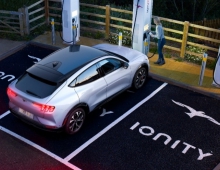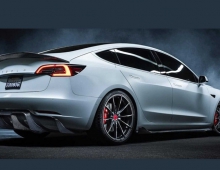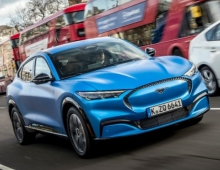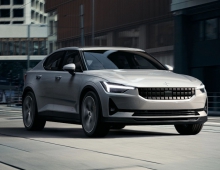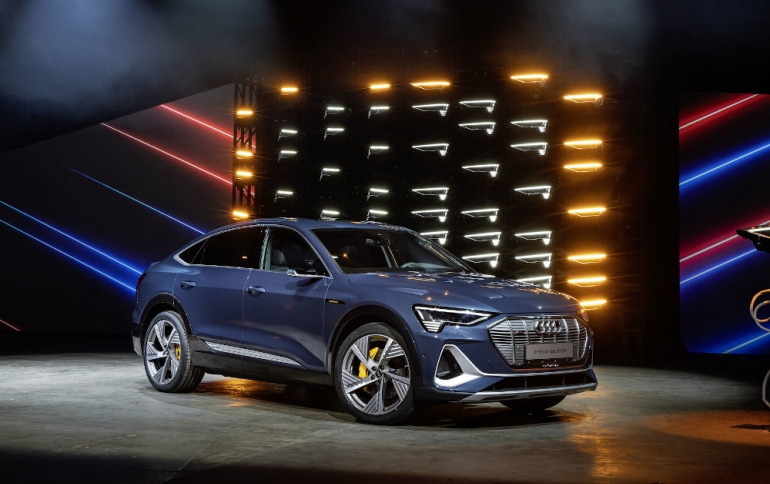
Audi Presents the e-tron Sportback
Audi is staying true to its strategic alignment by presenting the second electric model in its e-tron product line.
The Audi e-tron Sportback is a dynamic SUV coupé offering up to 300 kW of power and a range of up to 446 kilometers (277.1 miles) ( in the WLTP cycle) from a single battery charge (combined electric power consumption in kWh/100 km (62.1 mi): 26.3 - 21.6 (WLTP); 23.9 – 20.6 (NEFZ); combined CO2 emissions in g/km (g/mi): 0). Its digital matrix LED headlights are a new feature now available for the first time in a mass-production vehicle. Their light is broken down into tiny pixels and can be controlled with great precision. This makes safe lane centering easier on narrow stretches of road and shows the position of the vehicle in the lane.
The Audi e-tron Sportback can be ordered as of the end of November. Market introduction in Europe is scheduled for the spring of 2020.
The Audi e-tron Sportback combines the power of a SUV with the elegance of a four-door coupé and the progressive character of an electric car. It is 4,901 millimeters (16.1 ft) long, 1,935 millimeters (6.3 ft) wide and 1,616 millimeters (5.3 ft) high. Its roof extends flat over the body, dropping down steeply to the rear—in typical coupé style— and flowing into the steeply raked D-pillars. The lower edge of the third side window rises towards the rear—a typical Sportback feature.
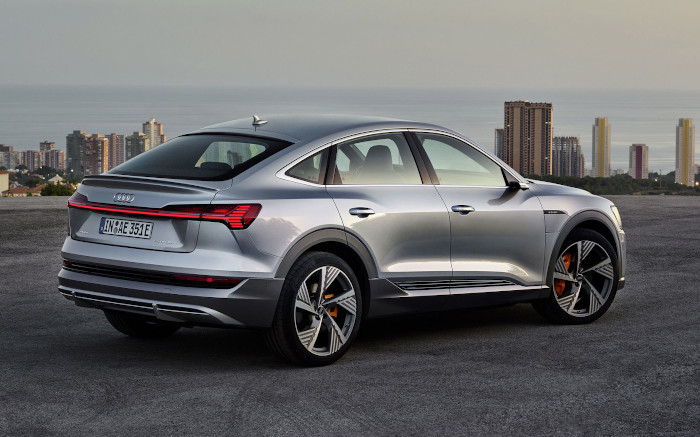
A total of thirteen paint finishes are available for the all-electric drive SUV coupé, including the new color plasma blue, metallic, which is exclusive to the e-tron Sportback. The logo on the electric charging flap features the high-voltage signal color orange, which can also be applied to the brake calipers on request. The wheel arch trims and sills are finished in matt anthracite as standard to underscore the off-road look. The same applies to the underbody protection, the diffuser, and the door sills, all of which are painted black. In the exterior line advanced, the attachments are finished in a contrasting gray or, as an option, in the body color. The underbody projection and diffuser then feature a matt silver tone.
The S line model places particular emphasis on the sporting DNA of the Audi e-tron Sportback. It is equipped as standard with 20-inch wheels and sport air suspension. The more distinctively contoured bumper is flanked by more expressive air curtains, which improve the air flow. They extend below the headlights, thereby creating a dynamic appearance even from a distance. An S line emblem adorns the radiator grille, while the illuminated aluminum door sill trims feature an #S logo. In contrast to the basic model, the attachments on the S line exterior are painted in the exterior body color – including the wheel arch trims, door sills, bumpers and exterior mirrors. Audi also offers the black styling package that accentuates the area of the Singleframe, the side windows, and the bumper. The exterior mirror housings are also available in black as an option.
The Audi e-tron Sportback in conjunction with the S line exterior and virtual exterior mirrors achieves an drag coefficient value of just 0.25—even better than its Audi e-tron sister model. This is primarily due to the coupé body shape and the associated lower aerodynamic drag behind the car. The high separating edge of the Sportback minimizes swirl in the air flow in this area, which ultimately also benefits consumption. In the WLTP cycle, the SUV coupé has a range of up to 446 kilometers (277.1 mi) on a single battery charge. Roughly 10 kilometers (6.2 miles) of the increased range compared to the e-tron can be attributed to the aerodynamically more favorable body. The optional virtual exterior mirrors, whose wing-shaped supports integrate small cameras, represent yet another efficiency factor. The captured images appear on high-contrast OLED displays in the transition between the instrument panel and the door. If the driver moves their finger toward the surface of the touch display, symbols are activated with which the driver can reposition the image. In addition, the mirrors adjust automatically to three driving situations: On the highway as well as during turning and parking maneuvers, they provide optimum visibility for each scenario. The aerodynamic refinement also extends to areas hidden from view. Among others, these include the controllable air intake with channels for cooling the front brakes, the aero wheels, and the fully lined underbody including the aluminum plate to protect the high-voltage battery.
With the digital matrix LED headlights as top-of-the range equipment, Audi presents a worldwide first in a production vehicle: Broken down into minute pixels, their light can illuminate the road in high resolution. The design is based on a technology abbreviated as DMD (digital micromirror device) and is also used in many video projectors. At its heart is a small chip containing one million micromirrors, each of whose edge length measures just a few hundredths of a millimeter. With the help of electrostatic fields, each individual micromirror can be tilted up to 5,000 times per second. Depending on the setting, the LED light is either directed via the lenses onto the road or is absorbed in order to mask out areas of the light beam.
In the Audi e-tron Sportback the digital light that will expand the offering in mid-2020, performs multiple tasks. It can generate dynamic leaving- and coming-home animations that appear as projections on a wall or on the ground. This presentation transforms the area in front of the car into a carefully illuminated stage. Not only does the digital light system deliver cornering, city, and highway lighting as versions of the low-beam light with exceptional precision, it also supplements the high-beam light by masking out other road users with even greater accuracy. Above all, however, it offers functions such as lane light and orientation light. On freeways, the lane light creates a carpet of light that illuminates the driver’s own lane brightly and adjusts dynamically when he or she changes lane. In this way, it improves the driver’s awareness of the relevant lane and contributes to improved road safety. In addition, the orientation light uses darkened areas masked out from the light beam to predictively show the vehicle’s position in the lane, thereby supporting—especially on narrow roads or in highway construction zones—the safe lane centering assist. The marking light function is also used in conjunction with the optional night vision assist. The light automatically draws attention to any pedestrians it detects, thereby reducing the danger of overlooking pedestrians in the immediate vicinity of the lane.
Each axle is fitted with an asynchronous electric motor that is fed with three-phase current by the power electronics. With an output of 265 kW and 561 Nm (413.8 lb-ft) of torque (combined electric power consumption in kWh/100 km (62.1 mi): 26.0 – 21.9 (WLTP); 22.7 – 20.6 (NEFZ); combined CO2 emissions in g/km: 0), the two standard electric motors pack a powerful punch in launching the SUV coupé from a standstill – locally emissions-free and in virtual silence. The Audi e-tron Sportback 55 quattro takes just 6.6 seconds (combined electric power consumption in kWh/100 km (62.1 mi): 26.0 – 21.9 (WLTP); 22.7 – 20.6 (NEFZ); combined CO2 emissions in g/km: 0) to reach 100 km/h (62.1 mph), and its top speed is electronically limited to 200 km/h (124.3 mph). By shifting from drive range D to S and fully depressing the accelerator pedal, the driver can activate boost mode. Here, the drive generates 300 kW of output and 664 Nm (489.7 lb-ft) of torque for eight seconds. This enables the SUV coupé to sprint from 0 to 100 km/h (62.1 mph) in 5.7 seconds. Two-stage planetary gearboxes with one gear range transfer the torque from the electric motors to the axles. A switch, which the driver can operate with the thumb and forefinger, is used to select the gears. It is embedded in a lever that is set low above the center tunnel and serves as a hand rest.
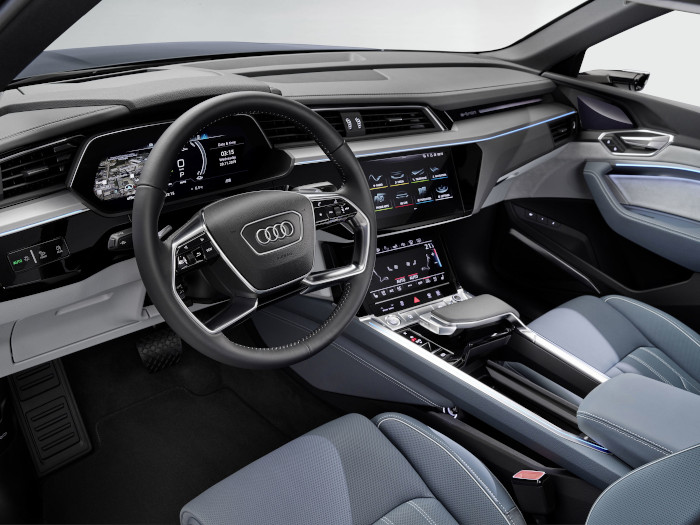
Electric all-wheel drive continuously regulates the ideal drive torque distribution between both axles—within fractions of a second. In most driving situations, the Audi e-tron Sportback relies exclusively on its rear electric motor. If the driver requests more output than it can provide, the front unit is instantly activated. This also happens predictively before slip occurs in icy conditions or when cornering fast, or if the car understeers or oversteers.
A key factor behind the sporty character and transverse dynamics is the low installation position of the drive components—resulting in a center of gravity that is much lower than in a conventional SUV. All of the heaviest components are concentrated in the center of the vehicle. The axle load distribution with a ratio of almost 50:50 is perfectly balanced; the self-steering behavior is neutral. With components such as the five-link suspensions, the progressive steering and the electrohydraulic brake system, the suspension combines the latest technologies, which together ensure agile vehicle handling and a high degree of comfort. The standard 255/55 R19 size tires stand out with their ultra-low rolling resistance. On request, tires of up to 22 inches will also be available from the middle of 2020—one size larger than on the e-tron.
The dynamic handling system Audi drive select—fitted as standard in the Audi e-tron Sportback—allows the driver to switch the method of operation of multiple drive components between seven profiles. This creates a marked difference between smooth rolling comfort and sporty, stable handling. The adaptive air suspension with controlled dampers provides a major contribution to this character. At higher speeds, the body is lowered, noticeably improving airflow around it and extending the vehicle’s range. In total, the system is capable of varying the ride height by up to 76 millimeters (3.0 in).
The battery system of the Audi e-tron Sportback 55 quattro stores 95 kWh of gross energy (86.5 kWh net) and operates at a rated voltage of 396 volts. It is fitted as a wide flat block beneath the passenger cell, to which it is bolted at 35 points. The battery system is exceptionally rigid and crash-proof—thanks to a solid protective frame and an aluminum laminate that holds the 36 cell modules. These are arranged on two levels, as a long lower “floor” with 31 modules and a short upper floor with five modules. Each module integrates twelve ‘pouch cells.’ The cooling system is located beneath the cell chamber.
During deceleration actions of up to 0.3 g—which applies to over 90 percent of such actions in everyday driving—the high-voltage battery is charged by the electric motors, primarily by the rear electric motor, which act as generators in these situations. The recuperation system provides for variable regulation of energy recuperation between both electric modules—both in coasting mode when the driver releases the right-hand pedal as well as during braking. The degree of coasting recuperation can be set to three stages by means of paddles on the steering wheel and is even more strongly differentiated than on the e-tron.
When braking from 100 km/h (62.1 mph), the Audi e-tron Sportback can recuperate a maximum of 300 Nm (221.3 lb-ft) and 220 kW. As with its sister model, this amounts to more than 70 percent of its output and more than any other production model. Overall, the SUV‑coupé attains up to 30 percent of its range through recuperation.
The wheel brakes come into play only at deceleration forces greater than 0.3 g. Depending on the driving situation, the control system decides individually for each axle whether the SUV coupé recuperates using just the electric motors, just the wheel brakes, or a combination of both. The transition between electric and hydraulic braking is smooth and homogeneous so the driver does not even notice it. Brake forces remain constant.
On the wheel brakes of the Audi e-tron Sportback, the developers have reduced what is referred to as residual brake torque—the losses that occur during brief application of the brake pads against the disk. This benefits both efficiency and range. The same applies to three additional measures: During normal vehicle operation, the front electric motor is almost completely decoupled from the drive. An increase in the usable range of the high-voltage battery combined with a reduction in several of the volume flows in the coolant circuit means that the pump has to provide less power.
The flexible thermal management, which comprises four separate circuits, regulates the temperature of the high-voltage components with maximum efficiency. This enables rapid DC charging, a long battery life cycle, and reproducible performance even under heavy loads. The standard heat pump, which harnesses waste heat from the high-voltage battery, can use up to 3 kW of actual power losses for heating and air conditioning the interior—which is very efficient. Depending on the outside temperature, that can boost the Audi e-tron Sportback’s range by up to ten percent in customer operation.
At market launch, Audi will offer the all-electric drive SUV coupé with a second motor variant. The e-tron Sportback 50 quattro generates 230 kW of output and 540 Nm (398.3 lb-ft) of torque (combined electric power consumption in kWh/100 km (62.1 mi): 26.3 - 21.6 (WLTP); 23.9 – 21.4 (NEFZ); combined CO2 emissions in g/km (g/mi): 0). The battery dispenses with the upper “floor;” and its 27 modules each consist of twelve prismatic cells. The system, which weighs roughly 120 kilograms (264.6 lb) less than the battery of the Sportback 55 quattro, provides 71 kWh of gross energy (64.7 kWh net). This allows the SUV coupé to cover up to 347 kilometers (215.6 mi) on a full charge in the WLTP cycle. The Audi e-tron Sportback 50 quattro accelerates from 0 to 100 km/h (62.1 mph) in 6.8 seconds and has a top speed of 190 km/h (118.1 mph) (combined electric power consumption in kWh/100 km (62.1 mi)*: 26.3 - 21.6 (WLTP); 23.9 – 21.4 (NEFZ); combined CO2 emissions in g/km (g/mi): 0).
On long-distance routes, the Audi e-tron Sportback 55 quattro can charge with direct current (DC) at up to 150 kW at fast-charging stations. In just under half an hour, the battery reaches 80 percent of its capacity—sufficient for the next leg of its long-distance trip. The e-tron Sportback 50 quattro can charge at up to 120 kW and achieves an identical charge status in the same time.
Charging at public AC charging stations can be performed using a standard mode-3 cable. Up to 11 kW of power is available here, which can be increased to 22 kW with an optional second on-board charging device that will be available in summer 2020. Audi’s own charging service, the e-tron Charging Service, provides easy access to almost 120,000 public charging points in 21 European countries – and the number is rising. Whether AC or DC, 11 or 150 kW—a single card is all that is required to start the process. The Plug & Charge function, which is also due to follow in 2020, will make charging even more convenient: The car authorizes itself at the charging station and activates it.
Audi also offers a range of solutions for charging in the garage at home, depending on the capacity of the domestic power supply. The standard compact charging system is suitable for a simple 230-volt connection and for a 400-volt three-phase outlet with an output of up to 11 kW. The optional charging stem connect will be available for ordering at market launch. It offers smart charging functions, for example preferred charging at low-cost times. The combination with a suitable home energy management system allows the vehicle to be charged preferably with self-generated solar power, provided that the house is equipped with a photovoltaic system.
With a wheelbase of 2,928 millimeters (9.6 ft), the Audi e-tron Sportback* has ample space for five occupants along with their bags. Rear headroom is just 20 millimeters (0.8 in) less than in the Audi e-tron. The rear footwell is virtually level—just a flat step remains in place of the center tunnel. Including the 60-liter (2.1 cu ft) stowage compartment underneath the hood, which houses the vehicle tool kit and charging cable, the car offers a total of 615 liters (21.7 cu ft) of luggage capacity. Folding down the rear seat backrests increases the luggage capacity to 1,655 liters (58.4 cu ft). The tailgate opens and closes electrically, by foot movement as an option.
As with all full-size class models from Audi, the e-tron Sportback also features the MMI touch response operating system with two displays. A tactile and acoustic pulse confirms when a finger activates a function. On the upper 12.1-inch touch screen, the driver controls the infotainment, telephony, navigation, and dedicated e-tron settings. The lower 8.6-inch display is used to input text and to operate the convenience functions and climate control. The menu structure is intuitively logical and flat in the same way as a smartphone; the graphics are clear and condensed.
Standard equipment on the Audi e-tron Sportback also includes the 12.3-inch Audi virtual cockpit. Its display excels with a resolution 1,920 x 720 pixels and can be switched between two views using the “View” button on the steering wheel. An optional “plus” version featuring an additional display centered around the power meter is also available. On request, the display and operating concept can be expanded to include a head-up display that projects important information onto the windshield.
In addition to operation by the two touch displays, the driver can activate a host of functions using natural language voice control. The system understands freely worded commands and search queries. The dialog manager asks questions if necessary, allows corrections, offers choices, and also defers to the speaker when interrupted. In doing so, it accesses information stored in the vehicle as well as the knowledge from the cloud.
In Germany, the Audi e-tron Sportback is equipped as standard with the MMI Navigation plus and the DAB+ digital radio. The top-end infotainment system supports the high-speed data transmission standard LTE Advanced and comes with an integrated Wi-Fi hotspot for the passengers’ mobile devices. The navigation system makes intelligent destination suggestions based on previous journeys. The route is calculated both on board in the car and online on the servers of the map and navigation provider HERE, which monitors the overall traffic situation in the region.
A further component of the package is the cloud-based Amazon voice service Alexa, which is fully integrated into the MMI operating system of the Audi e-tron Sportback. The driver can use it to perform a range of tasks such as placing orders and finding information about many current events. The service offers access to more than 80,000 Alexa Skills.
In addition, the free myAudi app can connect the car to a smartphone, which allows the owner of the Audi e-tron Sportback to manage all charging processes remotely. These include querying the battery and range status, starting the charge processes, programming timers, and displaying driving statistics.


